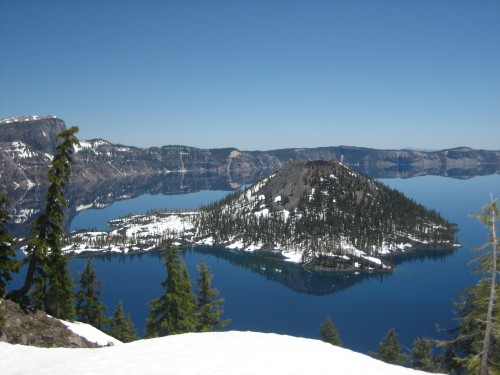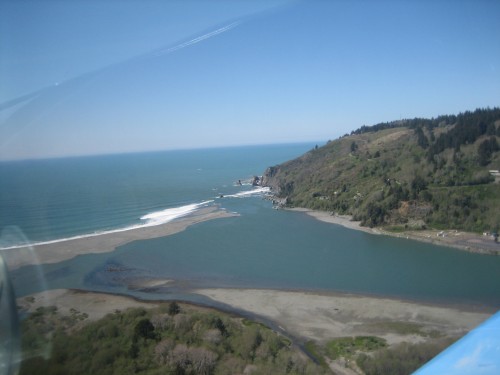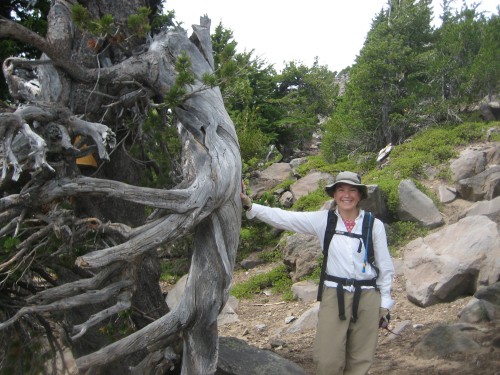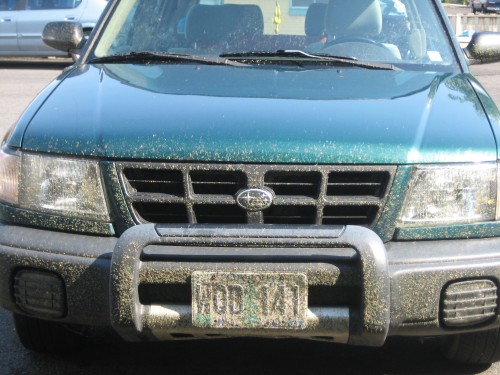Welcome to the State of Jefferson! Greetings especially to all of the Blogtrotters who are dropping in for the day.
I am writing from Klamath Falls, Oregon, very close to the border with California. But since 1941, many of the counties in southern Oregon and northern California have called themselves the State of Jefferson, after the third US president. There have been many reasons– political, topographical, and cultural– for the creation of this fictional state. I won’t get into those. For me, this area is all about water– water of many forms, states, temperatures, and in many places. As is often true in the American West, the water is a cause of and solution to many problems, and the source of many conflicts between people– farmers, native people, boaters, ranchers– and the local plants and animals. About ten years ago, Klamath Falls made national news because of the dramatic and somewhat violent clash between federal land managers, who shut down the irrigation due to drought and the survival of an ugly little group of species called the suckerfish, and the farmers and ranchers who formed actual bucket brigades to continue irrigating anyway. I live on Upper Klamath Lake, which is very long and shallow– only about 6-8 feet deep in most places. It is also what lake scientists call hypereutrophic, which basically means that lots and lots of stuff live in it– bacteria, algae, plants, fish, and so on.
I live on Upper Klamath Lake, which is very long and shallow– only about 6-8 feet deep in most places. It is also what lake scientists call hypereutrophic, which basically means that lots and lots of stuff live in it– bacteria, algae, plants, fish, and so on.
If you drive about an hour north of my house, you get to the north end of this crazy lake and, after driving up a mountain, you wind up at the deepest lake in the United States: Crater Lake.  Crater Lake sits in the caldera of a volcano that is still considered active– Mount Mazama. The lake is nearly 2,000 feet deep, and lake scientists call it ultraoligotrophic— which basically means that there is hardly any life growing in it at all, because it the water is so cold and pure.
Crater Lake sits in the caldera of a volcano that is still considered active– Mount Mazama. The lake is nearly 2,000 feet deep, and lake scientists call it ultraoligotrophic— which basically means that there is hardly any life growing in it at all, because it the water is so cold and pure.
I love the contrast of these two totally opposite bodies of water being right next to each other. It’s like the two siblings whose personalities are completely opposite being forced to share the back seat of the car for a long family road trip. “You think you’re so deep and mysterious?? Well, I have most of the surface area of the back seat, so there!” “Well, if you think I am going to waste my time talking to someone as shallow and germy as you, you can just forget it!”
 Of course like all siblings, even those who are complete opposites in personality, these two bodies of water share common blood. Crater Lake contains such a large volume of water and is at such a high elevation, that some of the water escapes. To the southeast of the lake, there is a little stream called Spring Creek that originates as freezing cold, pure water that comes out of the ground in hundreds of springs and then makes its way to the Williamson River, which feeds Upper Klamath Lake.
Of course like all siblings, even those who are complete opposites in personality, these two bodies of water share common blood. Crater Lake contains such a large volume of water and is at such a high elevation, that some of the water escapes. To the southeast of the lake, there is a little stream called Spring Creek that originates as freezing cold, pure water that comes out of the ground in hundreds of springs and then makes its way to the Williamson River, which feeds Upper Klamath Lake.

one of the springs that feed Spring Creek
Then the water (all of it that doesn’t get captured for irrigation, anyway) makes its way from Upper Klamath Lake into the Klamath River and south into northern California, where it curls west and north again, collecting more and more tributaries, until it enters the ocean near Crescent City, CA, just a hair south of the Oregon border. So, you see, even the ultraoligotrophic water eventually mixes with the hypereutrophic water and it all goes to the same place: the Pacific Ocean. Just like our mixed up watershed, there are lots of different people and lifestyles in the State of Jefferson. From sunbaked ranchers east of town to Shakespearean actors over the mountains in Ashland, from retired lumberjacks to retired bankers from the Bay area, to hippie bakers to F-15 pilots at the military base– there are all kinds of people here. And despite the disagreements about various issues like water and how to use it, I’ve found the atmosphere to be one of friendliness and care. So, I hope that you blogtrotters out there will come and explore this place non-virtually some day!
Just like our mixed up watershed, there are lots of different people and lifestyles in the State of Jefferson. From sunbaked ranchers east of town to Shakespearean actors over the mountains in Ashland, from retired lumberjacks to retired bankers from the Bay area, to hippie bakers to F-15 pilots at the military base– there are all kinds of people here. And despite the disagreements about various issues like water and how to use it, I’ve found the atmosphere to be one of friendliness and care. So, I hope that you blogtrotters out there will come and explore this place non-virtually some day!
PS: Please be sure to read the correction I put up after writing this post!
Read Full Post »
 It was an honor to work at Crater Lake for three summers, and exciting to be a part of the Crater Lake Science & Learning Center, which has only been operating for four years. At our year-end accomplishments presentation, the park superintendent said that Crater Lake’s Science & Learning Center was considered to be one of the most effective science and learning centers in the park service!
It was an honor to work at Crater Lake for three summers, and exciting to be a part of the Crater Lake Science & Learning Center, which has only been operating for four years. At our year-end accomplishments presentation, the park superintendent said that Crater Lake’s Science & Learning Center was considered to be one of the most effective science and learning centers in the park service!

















